An analysis of many results suggests a three-layer model of the proton.
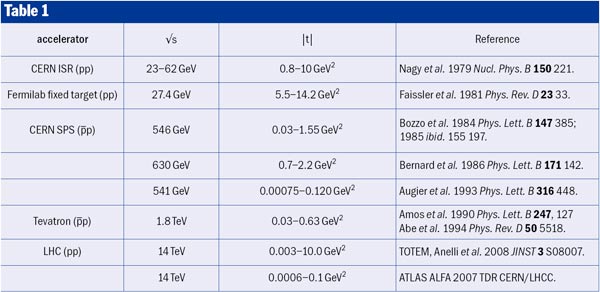
High-energy proton–proton (pp) and antiproton–proton (pp) elastic-scattering measurements have been at the forefront of accelerator research since the early 1970s, when pp elastic scattering was measured at the Intersecting Storage Rings (ISR) at CERN – the world’s first proton–proton collider – over a wide range of energy and momentum transfer. This was followed by measurements of pp elastic scattering in a fixed-target experiment at Fermilab, by pp elastic-scattering measurements at the Super Proton Synchrotron (SPS) at CERN operating as a pp collider and, finally, in the 1990s by pp elastic-scattering measurements at Fermilab’s Tevatron. Table 1 chronicles this sustained and dedicated experimental effort by physicists, which extended over a quarter of a century as the centre-of-mass energy increased from the giga-electron-volt region to the tera-electron-volt region.
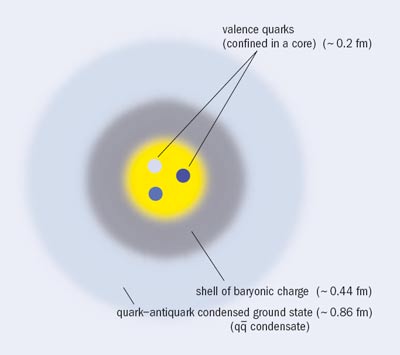
With the first collisions at CERN’s LHC on the horizon, pp elastic scattering will come under the spotlight at the experiment known as TOTEM – for TOTal cross-section, Elastic and diffractive scattering Measurement. The TOTEM collaboration has detailed plans to measure pp elastic scattering at 14 TeV in the centre-of-mass – that is, seven times the centre-of-mass energy at the Tevatron – over a range of momentum transfer, |t| around 0.003–10.0 GeV2. By contrast, the ATLAS collaboration at the LHC plans to measure pp elastic scattering at 14 TeV in the small momentum-transfer range, |t| around 0.0006–0.1 GeV2, where the pp Coulomb amplitude and strong interaction amplitude interfere.
A phenomenological investigation of high-energy pp and pp elastic scattering commenced in the late 1970s with the goal of quantitatively describing the measured elastic differential cross-sections as the centre-of-mass energy increased and as one proton probed the other at smaller and smaller distances with increasing momentum transfer. This three-decade long investigation has led to both a physical picture of the proton and an effective field-theory model that underlies the picture (Islam et al. 2009 and 2006).
Three-layer proton
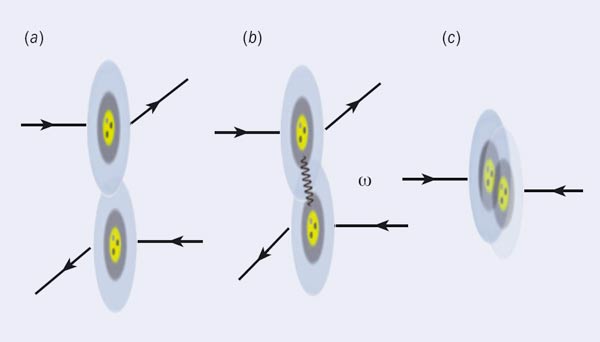
The proton appears to have three regions, as figure 1 indicates: an outer region consisting of a quark–antiquark (qq) condensed ground state; an inner shell of baryonic charge – where the baryonic charge is geometrical or topological in nature (similar to the “Skyrmion Model” of the nucleon); and a core region of size 0.2 fm, where the valence quarks are confined. The part of the proton structure comprised of a shell of baryonic charge with three valence quarks in a small core has been known as a “chiral bag” model of the nucleon in low-energy studies (Hosaka and Toki 2001). What we are finding from high-energy elastic scattering then is that the proton is a “condensate-enclosed chiral bag”.
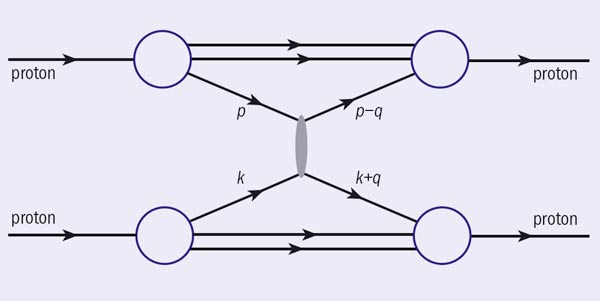
The proton structure shown in figure 1 leads to three main processes in elastic scattering, illustrated in figure 2. First, in the small |t| region, i.e. in the near forward direction, the outer cloud of qqcondensate of one proton interacts with that of the other, giving rise to diffraction scattering. This process underlies the observed increase of the total cross-section with energy and the equality of pp and pp total cross-sections at high energy. It also leads to diffraction minima, like in optics, which are visible in figure 5. Second, in the intermediate momentum-transfer region, with |t| around 1–4 GeV2, the topological baryonic charge of one proton probes that of the other via ω vector–meson exchange. This process is analogous to one electric charge probing another via photon exchange. The spin-1 ω acts like a photon because of its coupling with the topological baryonic charge. Third is the process in the large |t| region – where |t| is around 4 GeV2 or larger. Here one proton probes the other at transverse distances around or less than 1/q, where q = √|t|, i.e. at transverse distances of the order of 0.1 fm or less. Elastic scattering in this region originates from the hard collision of a valence quark from one proton with a valence quark from the other proton – a process that can be better visualized in momentum space (figure 3).
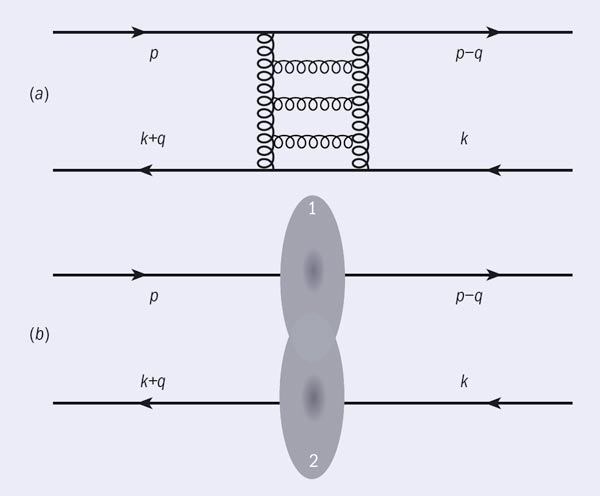
We have considered two alternative quantum-chromodynamical processes for the qq-scattering mechanism (represented by the blob in figure 3). One is the exchange of gluons in the form of ladders – called the “BFKL ladder” – as figure 4a shows. The other process we have considered is where the “dense low-x gluon cloud” of one quark interacts strongly with that of the other, as in figure 4b. The low-x gluons accompanying a quark are gluons that carry tiny fractions of the energy and longitudinal momentum of the quark. The finding of the high-density, low-x gluon clouds surrounding quarks is one of the major discoveries at the HERA collider at DESY.
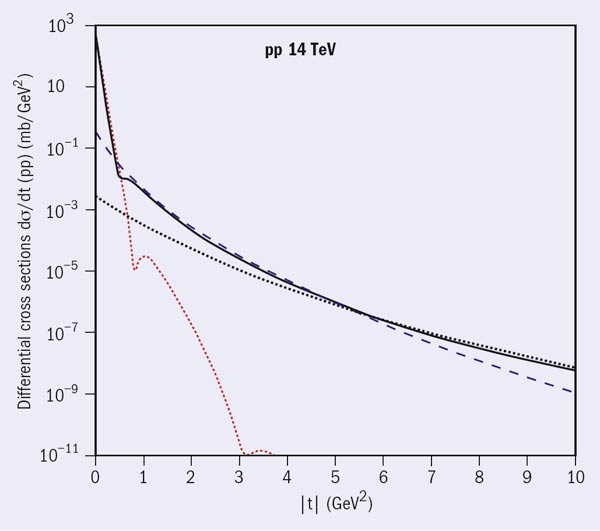
The solid curve in figure 5 shows our predicted elastic differential cross-section at the LHC at a centre-of-mass energy of 14 TeV and in the momentum-transfer region |t| = 0–10 GeV2 arising from the combination of the three processes – diffraction, ω-exchange, and valence quark–quark scattering (from low-x gluon clouds). The figure also indicates separately the differential cross-sections for each of the three processes. It shows that diffraction dominates in the small |t| region (0 <|t| <1 GeV2), ω-exchange dominates in the intermediate |t| region (1 <|t| <4 GeV2) and valence qq scattering dominates in the large |t| region (5 GeV2 <|t|).

In figure 6 we compare our predicted differential cross-section at the LHC with the predictions of several prominent dynamical models (Islam et al. 2009). A distinctive feature of our prediction is that the differential cross-section falls off smoothly beyond the bump at |t| around 1 GeV2. By contrast, the other models predict visible oscillations. Furthermore, these models lead to much smaller differential cross-sections than ours in the large |t| region, i.e. where |t| is greater than or about 5 GeV2.
If the planned measurement of the elastic differential cross-section by the TOTEM collaboration in the momentum-transfer range of |t| around 0–10 GeV2 shows quantitative agreement with our prediction, then it will support the underlying picture of the proton as depicted in figure 1. The consequent discovery of the structure of the proton at the LHC at the beginning of the 21st century would be analogous to the discovery of the structure of the atom from “high-energy” α-particle scattering by gold atoms at the beginning of the 20th century.
• The authors wish to thank the members of the TOTEM collaboration for discussions and comments.





